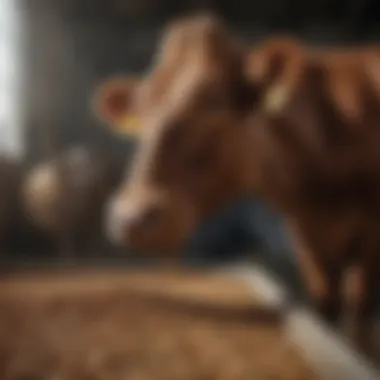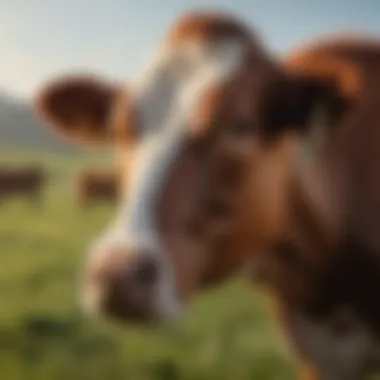Safeguard Dewormer for Cattle: Essential Insights


Intro
Cattle management is a challenging field, requiring a deep understanding of animal health and well-being. Among numerous factors influencing cattle health, the use of effective dewormers is pivotal. Safeguard dewormer pellets specifically stand out in this regard due to their formulation and proven efficacy. This guide aims to unfold the crucial aspects of these pellets, guiding agriculture farmers and enthusiasts towards making informed decisions.
Overview of the Topic
Definition and Importance
Safeguard dewormer pellets are primarily designed to combat gastrointestinal parasites in cattle. These parasites can significantly reduce productivity and overall health. Effective management of parasites is essential in sustaining livestock health, which directly correlates with the economic success of farms. Farmers must recognize the significance of these dewormers in keeping their herds healthy.
Current Trends
Recent trends suggest a shift towards more sustainable farming practices. Many farmers are now seeking products that not only ensure the health of livestock but also are environmentally friendly. Safeguard dewormer pellets align well with these trends, as they are developed with minimal impact on the ecosystem while effectively controlling pathogenic organisms in cattle. More farmers are adopting these practices, leading to enhanced productivity and animal welfare.
Key Techniques and Practices
Step-by-Step Guide
- Assess the Need for Deworming: Regularly evaluate whether your cattle may need deworming. Look for signs like weight loss or poor coat condition.
- Consult with a Veterinarian: Before implementing any deworming routine, seek professional advice to determine if Safeguard pellets are suitable for your herd.
- Administer the Pellets: Follow the dosage recommendations provided by the manufacturer or veterinarian. It’s crucial to observe the directions closely for effectiveness.
- Monitor Results: After deworming, observe your cattle for any changes in health or behavior. Keep records to track improvements and identify patterns in health management.
Tools and Equipment Needed
Implementing a deworming program requires certain tools and equipment. Key items include:
- Dewormer pellets: Specifically, Safeguard brand for effective treatment.
- Measuring scale: To accurately determine dosages.
- Record-keeping supplies: For monitoring health and treatment outcomes.
Challenges and Solutions
Common Obstacles
Farmers often face challenges like parasite resistance to dewormers or misapplication of dosages. Another obstacle may include limited access to veterinary advice, which can impede effective parasite control practices.
Innovative Solutions
To address these challenges, education plays a critical role. By participating in workshops or online forums, farmers can stay updated on the latest in deworming practices. Collaborating with local veterinarians ensures correct application of Safeguard pellets, helping to mitigate resistance issues and enhance the health of the herd.
“Effective deworming is more than just a routine; it's a cornerstone of sustainable cattle farming.”
Preface to Cattle Deworming
Cattle deworming is a critical aspect of animal husbandry that directly impacts the health and productivity of livestock. Internal parasites are common among cattle, and they can lead to significant economic losses on farms. Understanding the role of deworming is essential for farmers and cattle enthusiasts alike. It not only enhances the immediate well-being of the animals but also promotes long-term health.
Importance of Deworming in Cattle
Deworming plays a vital role in maintaining the health of cattle herds. Internal parasites can cause several problems, such as decreased feed efficiency, weight loss, and poor overall performance. Farmers often overlook the importance of regular deworming, however, it leads to substantial health issues that could have been prevented. Proper deworming programs contribute to better growth rates, improved reproduction, and higher milk yield in dairy cattle. Moreover, regular deworming can reduce the risk of developing resistance to deworming agents, ensuring effective control measures in the long run.
Common Internal Parasites Affecting Cattle
Various internal parasites affect cattle, and their prevalence can vary by region, season, and management practices. The most common parasites include:
- Gastrointestinal Nematodes: These include species such as Haemonchus contortus and Ostertagia ostertagi. They primarily affect the gastrointestinal tract and lead to anemia, diarrhea, and protein loss.
- Liver Flukes: Fasciola hepatica is a notable example, causing significant liver damage, which can severely affect productivity.
- Cestodes (Tapeworms): These parasites can reside in the intestines and interfere with nutrient absorption, leading to poor agricultural outcomes.
- Protozoans: The Eimeria species can cause coccidiosis, a disease that can severely affect younger cattle, leading to growth delays and mortality in severe cases.
Farmers should consider regular monitoring for these parasites and implement effective deworming schedules to sustain cattle health. By understanding both the importance of deworming and the parasites that impact cattle, stakeholders can make informed decisions that enhance their farming practices.
Overview of Safeguard Dewormer Pellets
In the realm of cattle management, understanding dewormers is crucial. The Safeguard Dewormer Pellets stands out in providing effective solutions for controlling internal parasites. This section covers essential aspects of these pellets, including their formulation and working principle. Knowing these factors helps farmers make informed choices for their livestock health.


Composition of Safeguard Pellets
The composition of Safeguard Dewormer Pellets is vital for its effectiveness. The primary active ingredient is fenbendazole, which is known for its broad spectrum against various parasites. The formulation usually has additional components that ensure stability and bioavailability.
- Active ingredient: Fenbendazole 20%.
- Binders and fillers: These materials are mixed with the active substance for shaping and delivery.
The balance of these components ensures that the body can absorb the drug adequately. This is especially important in pasture-based systems, where the likelihood of reinfection exists. Moreover, understanding the composition aids in grasping any potential sensitivities or reactions in specific cattle breeds.
Mechanism of Action
Safeguard Dewormer Pellets work primarily by disrupting the metabolism of parasites. The active ingredient, fenbendazole, targets the glucose uptake in worms. The following points outline the mechanism:
- Inhibits energy production: Fenbendazole interferes with the worms' ability to utilize glucose. This significantly depletes their energy resources.
- Disrupts structural integrity: It also affects the microtubules which are crucial for the worms' cellular structure, leading to their eventual demise.
This mechanism helps ensure a fast and effective reduction in parasite load in the cattle.
These features make Safeguard an important tool for maintaining the health and productivity of cattle. Understanding the mechanism allows farmers to appreciate the benefits and to consider best practices for administration.
Application Techniques for Safeguard Pellets
The application techniques for Safeguard dewormer pellets are crucial for ensuring their effectiveness. Proper handling and administration can significantly affect the overall health of the cattle and enhance the benefits of the treatment. By understanding how to apply these pellets effectively, farmers can optimize cattle health and productivity while managing parasite control in a systematic way.
Dosage Recommendations
Correct dosage is fundamental to achieving desired outcomes when using Safeguard dewormer pellets. Dosage depends on various factors, including the weight of the cattle, the severity of the parasite infestation, and the specific conditions of the farm. Generally, it is important to adhere to the manufacturer's guidelines.
- For adult cattle, the typical dosage is approximately 2.3 mg of fenbendazole per kilogram of body weight.
- For calves, dosages may vary, so it is vital to consult a veterinarian or the product label for precise recommendations.
- It is advisable to weigh the cattle before treatment to ensure the right amount is administered. This helps avoid underdosing, which could result in treatment failure or overdosing that might cause health issues.
Administration Methods
The method of administering Safeguard dewormer pellets also plays a pivotal role in their efficacy. Several methods can be employed, each with its own benefits and practicality.
- Oral Administration:
- Top-dressing:
- Water Dispersion:
- This is the most common method. The pellets can be mixed with feed to ensure the cattle consume them. It is essential that the pellets are evenly distributed to ensure all animals receive their dose.
- Another effective way is to apply the pellets directly on top of the grains or feed. This method can entice cattle to eat the treated feed without altering their feeding behavior significantly.
- In certain situations, it might be beneficial to dissolve the pellets into the water supply for cattle. This ensures that all animals have access to the treatment, especially in larger herd setups where monitoring individual intake is challenging.
Important: Always ensure cattle have an uninterrupted supply of clean water prior to administering the dewormer. This can help enhance the absorption and overall effectiveness of the pellets.
In summary, the application techniques for Safeguard dewormer pellets encompass dosage recommendations and administration methods. Each component must be considered carefully to ensure that the treatment is effective, yielding the best outcomes for cattle health and productivity.
Efficacy of Safeguard Dewormer Pellets
The efficacy of dewormers plays a critical role in cattle management. Safeguard dewormer pellets are designed to effectively target and eliminate internal parasites. Understanding how well these pellets work helps farmers make informed decisions regarding livestock health. This section focuses on specific elements like clinical studies and comparisons with other dewormers, giving a rounded view on the advantages of Safeguard pellets.
Clinical Studies and Findings
Clinical research substantiates the effectiveness of Safeguard dewormer pellets. Numerous trials have been conducted to analyze their impact on parasite reduction in cattle. In one study, researchers observed a significant reduction in Strongyloides and Haemonchus populations after administering Safeguard pellets. The study reported a 90% reduction in egg counts within two weeks post-treatment, which is crucial for controlling parasite life cycles.
Safeguard’s active ingredient, fenbendazole, has shown consistent results in various settings. Trials also highlight that animals treated with Safeguard exhibit better weight gains compared to untreated controls. Better weight gain reflects healthier cattle, directly translating to higher productivity for farmers. These findings illustrate why Safeguard pellets are often preferred for integrated parasite management.
Comparison with Other Dewormers
When evaluating the efficacy of Safeguard dewormer pellets, it is essential to compare them with other products available in the market. For instance, while Ivermectin is another popular dewormer, it primarily targets a different spectrum of parasites. Some studies indicate that Ivermectin may not be as effective against certain gastrointestinal worms that Safeguard targets effectively.
Additionally, some dewormers, like Levamisole, have shown variable efficacy and may require multiple doses to achieve comparable results. In contrast, Safeguard typically requires a single administration for optimal results, making it easier for farmers to manage their treatment regimen.


In summary, Safeguard dewormer pellets demonstrate strong efficacy when compared to other products. With evidence from clinical studies and consistent weight gain outcomes, it stands as a top choice for cattle owners seeking to maintain herd health. The combination of these findings supports the integration of Safeguard into routine cattle management practices.
Implications for Cattle Health
In the modern landscape of cattle farming, understanding the implications of using Safeguard Dewormer Pellets is crucial for maintaining herd health. The effectiveness of a deworming strategy significantly influences overall health status, growth performance, and sustainability of beef or dairy production. Getting rid of internal parasites is not only a matter of animal welfare but also a core component for profitable livestock management.
Impact on Weight Gain and Feed Efficiency
Deworming cattle with Safeguard pellets has direct and observable effects on weight gain and feed efficiency. Internal parasites compete with their host for nutrients. As these parasites consume the nutrients that cattle need to grow, there is a noticeable reduction in weight gain. Cattle that are free from such infestations are observed to gain weight more quickly, which translates to lowered feed costs and increased profitability.
Research shows that cattle treated with Safeguard Dewormer Pellets demonstrated improved Average Daily Gain (ADG) compared to untreated groups. The availability of nutrients, once competed for by parasites, enhances the processing of feed. By utilizing the energy stored in feed more efficiently, cattle can achieve better body condition and overall health.
- Key Findings:
- Enhanced weight gain observed post-treatment with Safeguard.
- Reduction in feed wastage due to more efficient nutrient utilization.
Long-term Health Benefits
The long-term health benefits of implementing a consistent deworming strategy cannot be overstated. Regular use of Safeguard Dewormer Pellets contributes to overall improvements in cattle health, leading to fewer diseases and better reproductive performance. Healthy cattle are more resilient against infections and other health challenges, which also promotes longevity.
Moreover, deworming plays a critical role in biosecurity practices. Preventing the spread of internal parasites reduces the risk of outbreaks that can have devastating effects on a herd’s health. This reduces the need for antibiotics and additional medical treatments, creating a more sustainable farming operation.
By ensuring that cattle are healthy over the long term, farmers can experience the following advantages:
- Improved Reproductive Performance: Healthy cows have better breeding outcomes, leading to increased calf production.
- Enhanced Milk Production: For dairy cattle, a well-managed deworming routine translates into better milk yields.
"A consistent deworming program ensures cattle maintain optimal health, leading to better productivity and, ultimately, profitability for farmers."
The use of Safeguard Dewormer Pellets is not merely a momentary solution, but an integral part of a holistic management plan aimed at promoting the well-being of the entire herd.
Best Practices for Implementation
Implementing effective deworming strategies with Safeguard Dewormer Pellets requires thoughtful planning and execution. Best practices facilitate not only the health of cattle but also optimize farm management and productivity.
Integrating into Farm Management Plans
Integrating Safeguard dewormer into overall farm management plans is crucial. A well-structured plan considers the life cycle of various internal parasites affecting cattle. By aligning the deworming schedule with grazing patterns, farmers can decrease parasite loads significantly.
Key considerations include:
- Assessment of Parasite Loads: Regular fecal examinations enable farmers to assess the severity of parasite infestations. This allows for targeted application of Safeguard pellets when necessary.
- Timing of Deworming: Implementing deworming protocols during strategic times of the year can align with the parasites’ breeding cycles. For instance, treating before seasonal changes like calving can protect young calves more effectively.
- Record Keeping: Maintain thorough records of all treatments, including dates and dosages. This practice helps in tracking efficacy over time and adjusting future strategies accordingly.
The integration of these practices can enhance cattle health and farm efficiency.
Regular Monitoring for Resistance
Regular monitoring for drug resistance is an essential part of managing the efficacy of Safeguard Dewormer. As parasites evolve, they may develop resistance to commonly used dewormers. To combat this, a proactive approach is necessary.
Some strategies include:
- Fecal Egg Counts: Frequent testing of fecal samples can help monitor the effectiveness of the deworming regimen. A significant drop in egg counts post-treatment indicates successful parasite control.
- Diversified Deworming: Rotating between different classes of dewormers can prevent the development of resistant strains. Using Safeguard pellets alongside other products can minimize the chances of resistance.
- Education and Training: Farmers should stay informed about new developments in parasite management. Workshops, webinars, and literature provide insights on emerging resistance patterns and new solutions.
Incorporating these monitoring practices ensures that the benefits of Safeguard Dewormer are sustained over the long term. Keeping accurate records and adapting strategies based on real-time data can optimize deworming outcomes.
"Effective parasite management is a dynamic process requiring continual adaptation."
Regulatory Considerations


In the domain of cattle management, understanding regulatory considerations is paramount. The correct usage of Safeguard Dewormer Pellets must align with governing mandates to ensure safety, efficacy, and environmental harmony. Navigating these regulations requires awareness of requirements outlined by both local and national agricultural authorities.
The key elements include:
- Ensuring compliance with labeling requirements.
- Understanding safety measures during application.
- Recognizing limitations set by various regulatory bodies.
These considerations are not just bureaucratic hurdles; they serve as essential guidelines that safeguard livestock health as well as consumer safety.
Labeling and Usage Guidelines
Labeling of Safeguard Dewormer Pellets is critical for farmers and professionals in the agriculture sector. Clear and comprehensive labels provide important information regarding active ingredients, dosages, and administration methods. This ensures that cattle are treated effectively while adhering to safety protocols.
Each package includes:
- Active Ingredients: An outlined list of what constituents are present. This is necessary for identifying the function of the product.
- Dosage Instructions: Clear instructions on how to administer the pellets based on cattle age and weight. Adhering to these dosages minimizes the risk of underdosing or overdosing.
- Withdrawal Periods: Information on how long the product must be administered before slaughter or milking. This is crucial for consumer safety.
Farmers should regularly review these guidelines to maintain best practices. It's crucial to follow the instructions to maximize effectiveness and safeguard cattle health.
Environmental Impact Assessments
The environmental impacts of using deworming pellets cannot be overstated. Regulations often mandate environmental impact assessments to evaluate how the use of Safeguard Dewormer Pellets affects the surrounding ecosystems. Understanding these impacts can guide farmers toward sustainable practices that do not harm the environment.
Some considerations in these assessments include:
- Ecosystem health: Evaluating how residues from the pellets may enter water systems or soil.
- Biodiversity: Looking at how the introduction of chemicals can affect local flora and fauna.
- Residual effects: Assessing how long remnants of the product remain in the system after administration. This affects both soil health and water quality.
Agricultural producers must assess these aspects to ensure they are employing practices that promote sustainability while maximizing productivity.
Effective regulation does not limit farming potential; it enhances the quality management of livestock and the environment.
Emerging Trends in Deworming Practices
The advancements in livestock management reflect a growing understanding of animal health needs, particularly in deworming practices. Emerging trends in this field hold significant implications for sustainable cattle farming. These trends are shaped by a combination of scientific research, technological innovations, and practical applications in the farming landscape. Understanding these trends is crucial for farmers seeking effective methods to maintain herd health and productivity.
Evolution of Deworming Protocols
The evolution of deworming protocols has seen a shift from routine deworming schedules to more targeted approaches. This transformation stems from greater awareness of parasite life cycles and resistance patterns. Farmers are now encouraged to conduct fecal egg counts before deciding on a treatment plan. This means that instead of automatically administering dewormers at scheduled intervals, farmers can tailor their approach to individual herd needs based on actual parasite loads. Such methods increase the efficacy of treatments and reduce the risk of developing resistance.
Farmers are also realizing the importance of rotating different classes of dewormers. This practice helps to minimize the chances of parasites developing resistance. Cycling through products such as Safeguard can maintain effectiveness in treating internal issues. Moreover, education on the correct usage of dewormers has become more readily available through industry resources, further improving herd management.
Technological Advances in Deworming
Technological advances in agriculture have introduced innovative tools and techniques to enhance deworming practices. One notable trend is the use of digital monitoring systems. These systems can track animal health data, including weight and health status, significantly impacting decisions regarding deworming. For instance, wearable devices that monitor cattle can alert farmers about health issues before they escalate.
Furthermore, automated systems for administering treatments are becoming common. These systems can improve accuracy and efficiency, ensuring that each animal receives the correct dosage at the right time. Additionally, advancements in genetic research are paving new paths for developing deworming solutions that target specific parasite genes. This precision medicine approach could revolutionize livestock management in the years to come.
"With the integration of technology in agriculture, farmers can make more informed decisions leading to better health outcomes for their herds."
Finales and Recommendations
In any discussion regarding cattle management, it is essential to synthesize valuable insights drawn from various aspects of deworming practices. The conclusions and recommendations of this article on Safeguard dewormer pellets encapsulate the significant benefits and considerations, aiming to provide actionable strategies for farmers. These recommendations not only focus on immediate outcomes but also consider long-term sustainability for cattle health and farm productivity.
Summarizing the Benefits of Safeguard Pellets
The use of Safeguard dewormer pellets has shown to be instrumental in enhancing cattle welfare. These benefits include:
- Efficient Parasite Control: Safeguard pellets effectively target a range of internal parasites. Keeping cattle free from parasites contributes greatly to overall health and productivity.
- Improved Weight Gain: Studies indicate that deworming with Safeguard correlates with better weight gain in cattle. Without the burden of parasites, the animals utilize their feed more efficently, leading to enhanced growth rates.
- Cost-effectiveness: The investment in Safeguard dewormer pellets often pays off through improved herd performance. Lower veterinary costs due to healthier cattle translate to more profit for farmers.
- Ease of Administration: The application of Safeguard pellets is straightforward. Their palatability assures that cattle consume them willingly, ensuring compliance with treatment protocols.
"Effective deworming is crucial for livestock health. Safeguard provides a reliable and efficient solution that aligns with modern agricultural best practices."
Future Directions in Cattle Deworming
Looking ahead, the field of cattle deworming is evolving. Here are some anticipated trends:
- Integration of Technology: Innovations such as digital monitoring tools are likely to aid in tracking deworming schedules and resistance patterns. This integration can refine treatment protocols for better herd management.
- Personalized Deworming Plans: Future deworming strategies may shift towards a tailored approach, considering individual animal health profiles rather than a one-size-fits-all solution. Such precision will enhance effectiveness.
- Research on Resistance Management: As resistance to dewormers continues to emerge, ongoing research into alternative treatments and rotation strategies will be critical. Staying informed about these advancements ensures farmers can adapt their practices wisely.
- Sustainability Focus: There is a growing emphasis on sustainable practices in agriculture. Future deworming methods will likely integrate environmentally friendly solutions that minimize the ecological impact of livestock farming.



